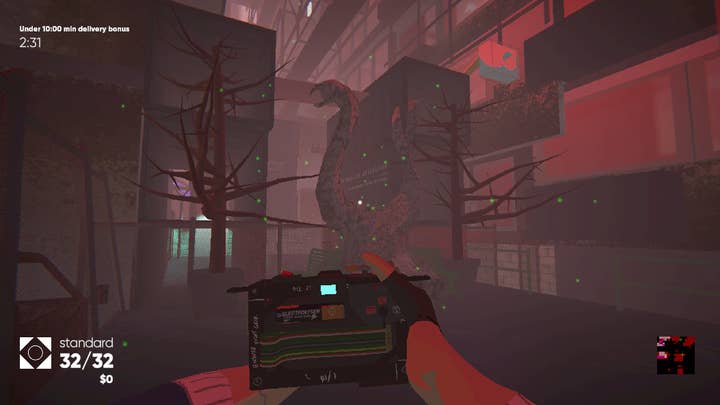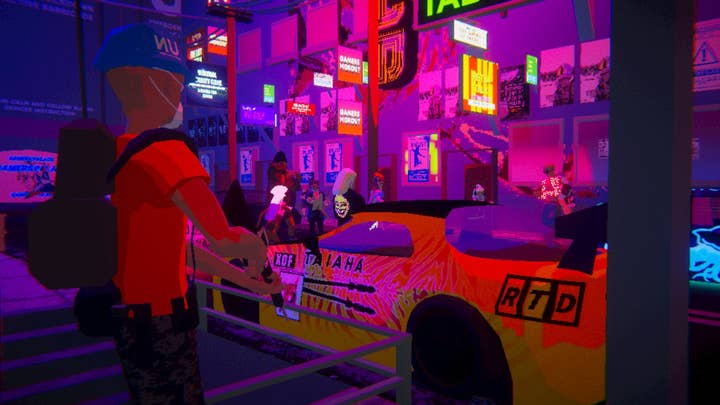Umurangi Generation's approach to modernizing cyberpunk
Naphtali Faulkner talks about the inspirations and intentions behind his sci-fi photography game
Umurangi Generation is a photography game, which puts it in the same general category as Pokémon Snap, Sea Life Safari, and Afrika.
But while it shares a primary mechanic, Umurangi Generation has a decidedly less cozy tone than those titles. Its Steam store page bills it as "a first person photography game in the shitty future," with the player tasked with capturing specific pictures while a crisis unfolds around them.
At first glance, the word "cyberpunk" comes to mind to describe the game's futuristic Tauranga setting, but speaking with GamesIndustry.biz recently, the game's director Naphtali Faulkner suggests that description fits more on the thematic level than the aesthetic one.
"I'm kind of frustrated with cyberpunk as a genre at the moment because it is so much aesthetic over thematic at this point," Faulkner says. "For the last ten years, it's been very much cyberpunk as an '80s circle jerk. And that's good, but I think [Cyberpunk pen-and-paper RPG creator] Mike Pondsmith was on the money there when he said it's like a mirror you hold up to what you're currently going through now."
He adds, "So in the '80s, cyberpunk was a reflection of the '80s. You had steroid-fueled machismo, megacorporations destroying the world, the surface-level black-and-white race issues, you had the drugs and all that stuff that was very relevant in the '80s because that's the world the '80s was in."
The idea for Umurangi Generation, he explains, was to make an equivalent cyberpunk that spoke not to the world of the '80s but to the world of today. So Faulkner's modern interpretation of the idea was inspired by everything from virtual reality to blockchain to neoliberal politics that have shaped the world between then and now.
"One of the things about a neoliberal political system is it's all about making you comfortable in the face of things that are going to kill you"
"One of the things about a neoliberal political system is it's all about making you comfortable in the face of things that are going to kill you," Faulkner says. "We can see that with this COVID-19 stuff, ads on TV trying to normalize the impact of it."
Faulkner notes that where he lives in Australia, TV ads have not been shy about using the pandemic to sell things, like talking about how important it is for people to stay in touch these days and then shilling an internet package with 25 gigs of data a month.
"They'll always talk around the problem that's currently facing them rather than what it actually is," he says. "They won't even name drop coronavirus or COVID-19. They'll just say social distancing is important so buy our product."
Faulkner sees that same refusal to stop and acknowledge the heart of a problem in one of the game's inspirations, the 2016 film Shin Godzilla, which offered a modern take on its source material in much the same way Urumangi Generation updates the idea of cyberpunk.
Where the original 1954 Godzilla used the eponymous monster as a stand-in for the greatest threat of its era in nuclear power, Faulkner reads Shin Godzilla as the film's embodiment of climate change.
And just as with climate change, the first warnings of Shin Godzilla's approach in Tokyo Bay are ignored, with the government denying the monster's existence despite evidence to the contrary.
"By the time they finish having that argument, Godzilla's evolved and he's on land. So the problem as it existed then has changed. Things have gotten worse. And that keeps happening through the story."
At the same time, the movie is also consciously evoking and responding to the Fukushima nuclear disaster of 2011 and the events preceding and following it.
"With Umurangi Generation, I took a similar approach in layering the ideas," Faulkner says. "Part of the strength of that layering is that players are coming away with different emotions toward the end."

That multi-layered approached to narrative was a natural fit with the photography mechanic at the heart of the game.
"It was really lucky that the gameplay setting in this game is all about taking photos. So essentially you've got the ability to get people to look at certain things"
"It was really lucky that the gameplay setting in this game is all about taking photos," Faulkner says. "So essentially you've got the ability to get people to look at certain things. Because if you tell them to take a photo of one thing and you set those objectives near something else, they're probably going to consume the story."
There's a lot of stuff going on in the game, Faulkner says, but players might not notice it at first if they're too focused on the objective in front of their noses. He expects those who are paying attention will piece together the story as they go, but if not, it eventually "slaps you in the face" around the midway point of the game.
It's an approach somewhat inspired by From Software's Souls games, where environmental storytelling goes beyond apocalyptic graffiti and audio logs. For example, players might identify a body based on the unique ring they pilfered off it, and then understand more about how that character died because of where their corpse lay.
Beyond rewarding perceptive players, Faulkner believes that approach also incentivizes people to replay the game in the hopes of getting more context they might have missed originally.
One place where he didn't follow the Souls playbook was in difficulty. Having explored photography on his own for about eight years, Faulkner wanted Umurangi Generation players to experience some of what he enjoyed about the hobby, and that meant being less prescriptive about what makes for a good picture.
"In terms of the creative side of it, I wanted to be really hands-off so that players aren't conditioned to be creative how I think they should be," he says. "The moment you tell someone what is or isn't creative, you've essentially stopped them from being creative because they're just learning by rote instruction. So the idea with this game is you can't punish creativity or players finding creative ways to do stuff."

Faulkner says his "secret sauce" is that players have the most fun when they're being creative, and giving negative feedback on that isn't helpful. In fact, he believes past negative feedback is commonly the reason people might balk at creative tasks in the first place.
"I think the reality is a lot of people have been crushed in the past, and they don't want to be creative because when they have been in the past, they've been pushed down and told they're not good at it," he says.
But if you give players the latitude to experiment and work on teaching them skills that let them execute on the ideas in their head, Faulkner believes they can grow to embrace creative tasks wholeheartedly.
"If you're playing [with creative mechanics] in a game and the game isn't ever punishing you and it's also got enough of a drip feed of gamified content to keep you going through it, I think eventually that switch will flick on in your head," Faulkner says.


